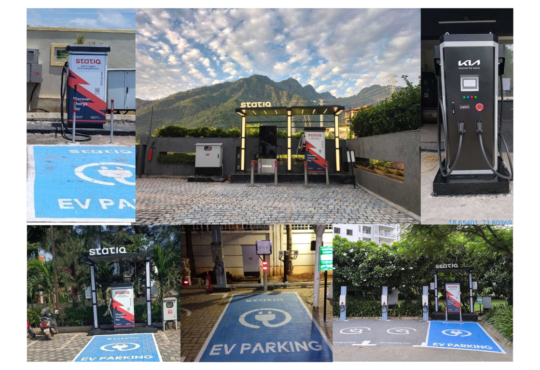
Impact of Renewable Energy on EV Charging Stations
Renewable energy sources are forms of energy that can be replenished naturally and sustainably, such as solar, wind, hydropower, geothermal, and biomass. They are important in the transition to sustainable energy systems because they do not deplete natural resources, produce harmful emissions or waste, and have lower carbon footprints than non-renewable sources of energy such as fossil fuels. The integration of renewable energy sources with EV charging stations is a promising development in sustainable energy systems. They can provide the electricity needed to charge electric vehicles, reducing the carbon footprint of transportation.
Additionally, the batteries in EVs can act as energy storage systems, allowing excess renewable energy to be stored and used when needed, helping to balance the grid. However, the increased demand for electricity to power these vehicles also presents challenges for the grid and renewable energy infrastructure. In this blog, we will explore the opportunities and challenges of integrating renewable energy sources with EV charging.
Opportunities for Integrating Renewable Energy Sources in EV Charging Stations

Integrating renewable energy sources with EV charging presents numerous opportunities that can significantly benefit the transition to a cleaner, more sustainable energy system. Such as:
- Enabling a cleaner and more sustainable transportation system: By providing renewable energy to power electric vehicles, it is possible to significantly reduce the transportation sector’s reliance on fossil fuels, which are a major source of greenhouse gas emissions. Renewable energy sources such as solar, wind, and hydropower are clean and sustainable, which means that they can be used to power EVs without increasing emissions or harming the environment.
- Reducing greenhouse gas emissions and air pollution: Integrating renewable energy sources with EV charging can help reduce greenhouse gas emissions and air pollution. This is because renewable energy sources emit no greenhouse gases or air pollutants during their operation. By using renewable energy to power EVs, the overall carbon footprint of the transportation sector can be reduced.
- Enhancing energy security and resilience: Diversifying the energy mix and reducing the dependence on fossil fuels can enhance energy security and resilience. This is because renewable energy sources are distributed and often decentralized, which makes them less vulnerable to supply disruptions and price fluctuations.
- Leveraging the flexibility and controllability of EV charging for grid balancing: EV charging can be flexible and controllable, which means that it can be adjusted to match the availability of renewable energy sources. This enables it to be used for grid balancing, helping stabilize the grid and reducing the need for fossil-fuel-based peaking power plants.
- Unlocking new business models and revenue streams: The integration of renewable energy sources with EV charging can create new business models and revenue streams. For example, energy companies can offer renewable energy-based EV charging as a service, and EV owners can earn money by selling excess energy stored in their EV batteries back to the grid.
Overall, the integration of renewable energy sources with EV charging stations presents significant opportunities that can help reduce emissions, enhance energy security and resilience, and create new business models and revenue streams.
Challenges of Integrating Renewable Energy Sources

Integrating renewable energy sources with EV charging also presents several challenges that must be addressed to ensure the successful adoption and implementation of this technology. Some of the key challenges are:
- Variability and intermittency of renewable energy sources: Renewable energy sources such as solar and wind power are variable and intermittent, which means that their availability can be unpredictable. This presents a challenge for integrating them with EV charging, as it can be difficult to match the supply and demand of renewable energy with the charging needs of EVs.
- Matching the demand and supply of EV charging and renewable energy: The demand for EV charging can be highly variable, which can make it challenging to match it with the supply of renewable energy. This requires sophisticated systems and technology to manage and coordinate the charging of EVs with the availability of renewable energy sources.
- Grid integration and stability issues: The integration of renewable energy sources can create grid integration and stability issues due to the increased load of EVs and the variability of renewable energy. It requires careful planning and investment in grid infrastructure to ensure that the grid can handle the increased load and variability.
- Cost and complexity of infrastructure and equipment: The integration of renewable energy sources with EV charging requires significant investment in infrastructure and equipment. This can be expensive and complex, especially in areas where renewable energy sources are not readily available and grid infrastructure needs to be upgraded.
- Regulatory and policy barriers: The lack of supportive policies and regulations for the deployment of renewable energy sources and EV charging infrastructure can hinder the integration of renewable energy sources. This requires a coordinated and collaborative effort among stakeholders, including policymakers, regulators, and industry players, to overcome these barriers.
Overcome the Challenges: Discussing Possible Solutions
Here are the possible solutions to overcome the challenges of integrating renewable energy sources with EV charging:
- Advancing renewable energy and energy storage technologies: The development of renewable energy sources such as solar and wind power, as well as the advancement of energy storage technologies such as batteries and pumped hydro storage, can help provide more reliable and cost-effective renewable energy to power EV charging.
- Implementing smart charging and vehicle-to-grid (V2G) systems: Smart charging systems can automatically adjust the charging rate of EVs to match the availability of renewable energy sources. V2G systems can also enable EVs to supply energy back to the grid during peak demand periods, further improving grid stability.
- Coordinating and optimizing EV charging and renewable energy management: Coordinating the charging of EVs with the availability of renewable energy sources can help reduce the need for fossil fuel-based power plants. Optimizing the management of renewable energy sources can also help ensure that they are being used efficiently and effectively.
- Developing supportive policies and regulations: Governments can develop policies and regulations that encourage the deployment of renewable energy sources and the adoption of EVs. For example, they can provide incentives for renewable energy production and EV purchases or mandate the use of renewable energy in certain sectors.
- Encouraging collaboration and partnerships among stakeholders: Collaboration and partnerships between charging infrastructure providers, renewable energy producers, and other stakeholders can help promote the development of integrated renewable energy and EV charging solutions. Such collaborations can also help ensure that the needs and perspectives of all stakeholders are taken into account.
Future Prospects
The future prospects for integrating renewable energy sources with EV charging stations are promising, with increasing deployment of renewable energy, improvements in energy storage technology, and advances in EV charging infrastructure. Many governments and businesses have set targets for decarbonizing transportation, which will drive growth in renewable energy and EV adoption.
The ongoing development of smart charging and vehicle-to-grid systems will further enable the integration of renewable energy and EV charging. Overall, the integration of renewable energy sources with EV charging stations can play a critical role in achieving a more sustainable and resilient energy system.
Also read, Beat the Heat: Follow 5 EV Driving Tips in Summer
FAQs
What is renewable energy and why is it important for EV charging stations?
Ans. Renewable energy is energy from sources that are naturally replenished, such as solar, wind, hydro, and geothermal power. It is important for EV charging because it can help reduce greenhouse gas emissions and improve the sustainability of transportation.
What are some examples of renewable energy sources that can be integrated with EV charging?
Ans. Solar power, wind power, and hydropower are some of the renewable energy sources that can be integrated with EV charging.
What are the benefits of integrating renewable energy sources with EV charging?
Ans. The integration of renewable energy will provide a cleaner and more sustainable way to power transportation.
What are the challenges of integrating renewable energy sources with EV charging stations?
Ans. Some challenges of integrating renewable energy sources with EV charging include:
- Intermittency of renewable energy sources
- Lack of infrastructure,
- Need for smart charging technologies
How can these challenges be overcome?
Ans. These challenges can be overcome through
- Advancements in renewable energy and energy storage technologies
- Implementation of smart charging and vehicle-to-grid systems
- Coordination and optimization of charging and renewable energy management
- Supportive policies and regulations
- Collaboration among stakeholders
What are the current trends and future outlook for integrating renewable energy sources with EV charging?
Ans. Many governments and businesses are committing to decarbonizing transportation by integrating renewable energy sources with EV charging. The future outlook is for continued growth in EV adoption and renewable energy deployment.
What role do policies and regulations play in the integration of renewable energy sources with EV charging?
Ans. Policies and regulations play an important role in promoting the integration of renewable energy sources with EV charging by providing incentives, setting targets and creating a supportive regulatory framework.
What are some innovative technologies being developed to facilitate the integration of renewable energy sources with EV charging?
Ans. Some innovative technologies are
- Wireless charging
- Bidirectional charging
- Blockchain-enabled energy transactions
How can consumers play a role in promoting the integration of renewable energy sources with EV charging?
Ans. Consumers can play an important role by using electric vehicles as transportation supporting renewable energy deployment and participating in smart charging programs.
How can businesses and industries benefit from the integration of renewable energy sources with EV charging?
Ans. Businesses and industries can benefit through reduced operating costs, increased energy independence, and improved sustainability credentials.



